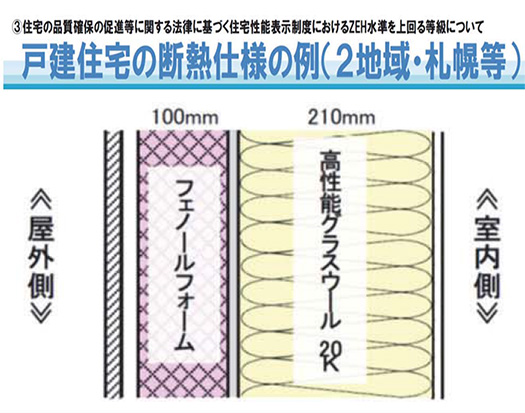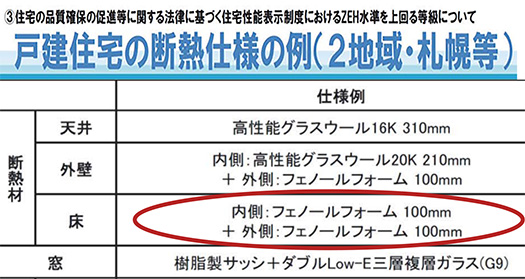

感染症による社会閉塞、通常のコミュニケーションが不通となるなかで
国交省からこれまでの省エネ等級基準に対してあらたに
等級6と7が発表され、国会でも通過した。
こうした状況を受けて建築業界の「世論」がどう反応していくのか、
依然として感染症による他者非難の暴風圧があるなかでは
自由闊達な意見交換機会が再開されるまでに至っていない。
本来、国の基準更新はもっと自由な対話環境が必要ではないかとは思う。
まぁしかし、現実はこのように進行しているので対応して行く必要がある。
寒冷地では自由往来も限定され住宅関係の団体ミーティングも
ようやく6月くらいから萌芽的に再開してきている。
北海道でも来週にアース21の例会がリアルとZoomのハイブリッド開催。
新住協札幌支部の会合も「現場見学会」のみ先週開催というところ。
当然、省エネ等級更新、最上位等級7についての
自由な意見交換もまだ聞くことが出来ない。
そんななか、新住協関西支部の6月の勉強会が開催されて
久しぶりに鎌田紀彦代表理事の講演を聴講することができた。
今回の等級7基準について、それに対応する断熱手法を検討するもの。
関西支部での勉強会なので基本的には温暖地域での対応法が検討されていた。
ただ、わたし的には寒冷地1〜2地域での断熱手法に当然興味を持っていた。
徹頭徹尾、図表と数式による講演でしたが、
そのなかで寒冷地に示されていたのは図のような外壁構成。
案の上ではありますが、北海道では壁厚300mm超というのが対応法になる。
断熱材の厚みで210+100mmで、その外側に外装が施される想定。
壁厚は普通に考えれば350mm超になっていく。
単純に4間四方の16坪平面の住宅を想定すると、おおむね3坪面積相当の
断熱壁ということになる。比例で言えば100:18.75の比率。
パッシブハウスというドイツ主唱の基準は北海道ではほぼ無理筋と
一顧だにされなくなった。それが寒冷地住宅市場の常識的反応。
少なくとも都市環境・狭小敷地化が進行する最大消費地域・札幌で
外壁占有率が2割近いというのは現実的ではないという市場反応です。
人間は外壁をつくるために家を建てるのではない。
たのしく暮らすために家を建てるのであって、基準のためではない。
また鎌田先生の講演ではこの基準対応のコストアップが
かなり大幅にならざるを得ず、ユーザーの支持が得られるかどうか、
といった提起もされていた。課題の最先端地域そのもの。
温暖地の住宅性能を向上させる基準誘導には意味がある。
いま北海道で普通に建てられている断熱仕様の住宅を温暖地で建てれば
最高等級7は容易に実現する。寒冷地市場が先導して実現のコスト合理性もある。
しかし一方で、寒冷地域のユーザーはこの新基準にどう反応していくか、
かなり視界不透明ではないかという印象を持った次第。・・・
English version⬇
New Energy Conservation Standard, Highest Grade 7, Now in Cold Regions?
The cold region housing market has pioneered energy-saving insulation methods and achieved cost reductions through mass construction. Now, with the Grade 7 standard, we are once again at the “cutting edge of the issue. …
Amidst the social blockage caused by infectious diseases and the lack of normal communication
The Ministry of Land, Infrastructure, Transport and Tourism (MLIT) has announced new energy conservation grade standards
The Ministry of Land, Infrastructure, Transport and Tourism (MLIT) has announced new energy efficiency rating levels 6 and 7, which were also passed by the Diet.
How will “public opinion” in the building industry react to this situation?
With the storm pressure of blaming others due to infectious diseases still in place, it is difficult to know how the public will react.
The opportunity for a free and vigorous exchange of opinions has not yet resumed.
In essence, I think that the renewal of national standards requires a more liberal environment for dialogue.
Well, however, the reality is that this is the way things are progressing, and we need to deal with it.
In cold climates, free traffic is limited and housing-related group meetings are not being held.
Finally, meetings of housing-related organizations have begun to sprout from around June.
In Hokkaido, the Earth 21 meeting will be held next week as a hybrid of real and Zoom.
The Shinjyukyo Sapporo Chapter also held a “site tour” only last week.
Naturally, the free exchange of opinions on the renewal of the energy efficiency rating, the highest rating of 7, has yet to take place.
The New Jyukyo Kansai Branch is also holding a hybrid meeting of real life and Zoom.
In the meantime, the June study meeting of the Shinjyukyo Kansai Branch was held.
I was able to listen to a lecture by Representative Director Norihiko Kamata for the first time in a while.
The lecture was about the new Grade 7 standard and the corresponding heat insulation methods.
Since it was a study session of the Kansai Branch, basically the methods to be used in warm regions were discussed.
However, I was naturally interested in the insulation methods for the first two cold regions.
The lecture was based entirely on charts and mathematical formulas.
In the lecture, he showed the exterior wall configuration for cold regions as shown in the figure.
Although it is just a suggestion, in Hokkaido, the corresponding method is to have a wall thickness of over 300 mm.
It is assumed that the thickness of the insulation is 210 + 100 mm, and the exterior is applied on the outside of the insulation.
The wall thickness would normally be over 350mm.
Assuming a simple 4-ken square 16 tsubo flat house, this means that the insulation wall is equivalent to an area of approximately 3 tsubo.
It means that the insulation wall is equivalent to about 3 tsubo area. The ratio is 100:18.75.
The German standard of “passive house” is now considered to be almost impossible in Hokkaido.
The German standard of “Passive House” is no longer considered a viable option in Hokkaido. This is the common-sense reaction of the cold-region housing market.
At least in Sapporo, the largest consumption area in Japan, where the urban environment and small lot sizes are progressing, the percentage of exterior walls occupied by houses is close to 20%.
The market reaction is that an exterior wall occupancy rate of nearly 20% is unrealistic, at least in Sapporo, the largest consumption area in Japan, where urban environments and small lot sizes are progressively being developed.
People do not build houses to build exterior walls.
They build houses to live happily, not for the sake of standards.
In addition, Dr. Kamada’s speech showed that the cost increase to comply with this standard would have to be quite large, and that the support of users would be very important.
The cost increase to comply with this standard would have to be quite large, and he wondered whether he would be able to gain the support of users.
The area itself is at the forefront of the issue. The region itself is at the forefront of the issue.
It is meaningful to induce standards that improve housing performance in warmer regions.
If houses with insulation specifications that are commonly built in Hokkaido are built in warmer regions, it is easy to achieve the highest grade 7.
the highest grade 7 can be easily achieved. The cold-region market is leading the way, and there is cost rationality in achieving this.
On the other hand, however, I have the impression that users in cold regions may not be so sure about how they will react to the new standard.
I have the impression that the market in cold regions is not very clear. …
Posted on 6月 25th, 2022 by 三木 奎吾
Filed under: 住宅マーケティング, 住宅性能・設備







コメントを投稿
「※誹謗中傷や、悪意のある書き込み、営利目的などのコメントを防ぐために、投稿された全てのコメントは一時的に保留されますのでご了承ください。」
You must be logged in to post a comment.